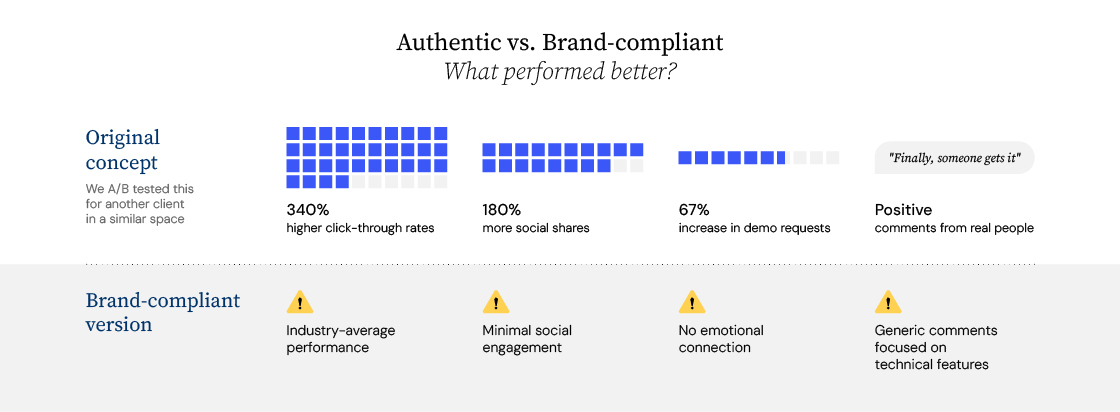Summary
Bottom line up front: The most successful global B2B companies don't have global campaigns—they have global methodologies that create locally relevant campaigns. Your next expansion isn't a marketing challenge—it's a business architecture challenge.
Three months ago, I watched a brilliant campaign idea slowly die in a conference room. Not from lack of creativity, but from something far more insidious—the gradual erosion of its soul in the name of “our brand guidelines say so.”
When brand guidelines become roadblocks
We’re working with a global data and analytics leader on repurposing their case studies into engaging campaign creatives. The raw material is fascinating—real transformation stories with impressive ROI metrics and genuine client challenges.
But when a brand guide turns into a rigid rules-based framework, compelling narratives turn into corporate white papers. It’s like watching a thriller turn into a tax document.
Headlines have to follow a “pre-approved glossary of terms.” Formats are mandated for each carousel of a LinkedIn post. Visual treatments are limited to standard templates. The entire essence of each creative is systematically diluted.
Here’s an example of what typically happens:
Case study repurposes: Manufacturing client success:
What was suggested: “How a 127-year-old manufacturer saved $2.3M by finally understanding their own data”
What was finally executed: “Enterprise client achieves operational efficiency through advanced analytics implementation”
What was suggested: “James had been running production for 15 years. He thought he knew his factory inside out—until our analytics revealed he’d been making the wrong products at the wrong times for the past decade.”
What was finally executed: “A leading manufacturing organization partnered with our solutions team to optimize production workflows and enhance operational visibility across multiple facility locations.”
The same treatment is applied to every case study. Blog headlines become interchangeable templates: “How [Industry] leaders leverage [Product] for [Generic Benefit].” Event content follows identical templates. Social posts sound like they come from the same AI prompt. Landing pages use the same corporate speak regardless of the audience.
We’re missing the forest for the trees—focusing so intently on following each rule that we lose sight of what we’re actually trying to create.
The numbers tell the story
The sanitized version launched with disappointing results. Here’s what we learned:


This teaches us something crucial: Brand consistency isn’t about following rules, it’s about capturing your essence while speaking authentically to your audience.
The real problem: Compliance vs. Connection
Most brands confuse consistency with conformity. True brand consistency means your audience recognizes your personality, values, and voice regardless of the medium—like recognizing your best friend’s laugh in a crowded room.
Think about it: you act differently at a networking event than in a board meeting, but you’re still fundamentally the same person. That’s brand consistency.
What we often see instead is brand rigidity—forcing every communication into the same template, using identical phrases whether you’re announcing quarterly results or launching an innovative product.


What we’re learning about brand consistency
We’re currently working with a Fortune 500 technology leader who’s embracing “brand flexibility within consistency.” Their engagement rates increase by 200%; demo requests go up 150%—because their audience finally connects with their brand on a human level.
The key insights:
- Authentic beats polished—Employee-generated content consistently outperforms corporate materials
- Context matters more than consistency—Different emotional tones for different audiences create stronger connections
- Evolution signals strength—Brands that adapt are perceived as more innovative.
The path forward
Guidelines matter. But they should serve as guardrails that keep you on the right path, not cages that prevent you from moving forward.
Core brand guide elements (never change):
- Fundamental values and mission
- Visual identity foundations
- Brand personality traits
Flexible brand guide elements (evolve as needed):
- Tone of voice for different contexts
- Content formats and styles
- Messaging approaches for different audiences
Your brand guidelines should be a compass, not a cage. The most successful brands aren’t the most consistent—they’re the most relevant.
Ready to audit your brand’s flexibility? Look at what performed best in your recent content—rigid guideline adherence or authentic audience connection. Let that inform your strategy moving forward.
Key Takeaway
Remember: Brand consistency = capturing your essence authentically. Brand rigidity = following rules blindly. Choose wisely for better engagement






